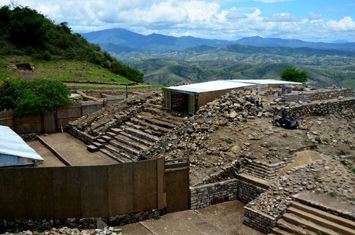From the Trenches
Burials and Reburials in Ancient Pakistan
By JARRETT A. LOBELL
Monday, February 11, 2013
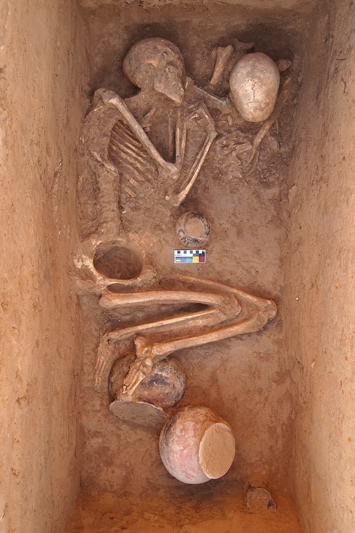 When development work began on a parcel of land in the village of Udegram in Pakistan’s Swat Valley, the landowner likely never imagined that he would find a human burial. Soon a team of archaeologists, working with funding from the Archaeology, Community, and Tourism Project of the Pakistani-Italian Debt Swap Program, persuaded him to stop building for a year while they excavated the site. They uncovered not just a lone burial, but more than 30 graves that are approximately 3,000 years old. Many of the burials have two skeletons, which Luca Maria Olivieri of the Italian Archaeological Mission, one of the archaeologists working on the site, believes is evidence of a complex funerary ritual. “This [ritual] involved decomposition in graves enclosed in wooden fences, reopening of the graves for a second burial and partial burning of the bones, sealing the graves, and, finally, the construction of a burial mound,” says Olivieri. The burials contain a great many grave goods, including high-quality ceramics, cloth, copper and bronze pins, ivory spindles, and chlorite spinning whorls.
When development work began on a parcel of land in the village of Udegram in Pakistan’s Swat Valley, the landowner likely never imagined that he would find a human burial. Soon a team of archaeologists, working with funding from the Archaeology, Community, and Tourism Project of the Pakistani-Italian Debt Swap Program, persuaded him to stop building for a year while they excavated the site. They uncovered not just a lone burial, but more than 30 graves that are approximately 3,000 years old. Many of the burials have two skeletons, which Luca Maria Olivieri of the Italian Archaeological Mission, one of the archaeologists working on the site, believes is evidence of a complex funerary ritual. “This [ritual] involved decomposition in graves enclosed in wooden fences, reopening of the graves for a second burial and partial burning of the bones, sealing the graves, and, finally, the construction of a burial mound,” says Olivieri. The burials contain a great many grave goods, including high-quality ceramics, cloth, copper and bronze pins, ivory spindles, and chlorite spinning whorls.
The First Spears
By ZACH ZORICH
Thursday, February 28, 2013
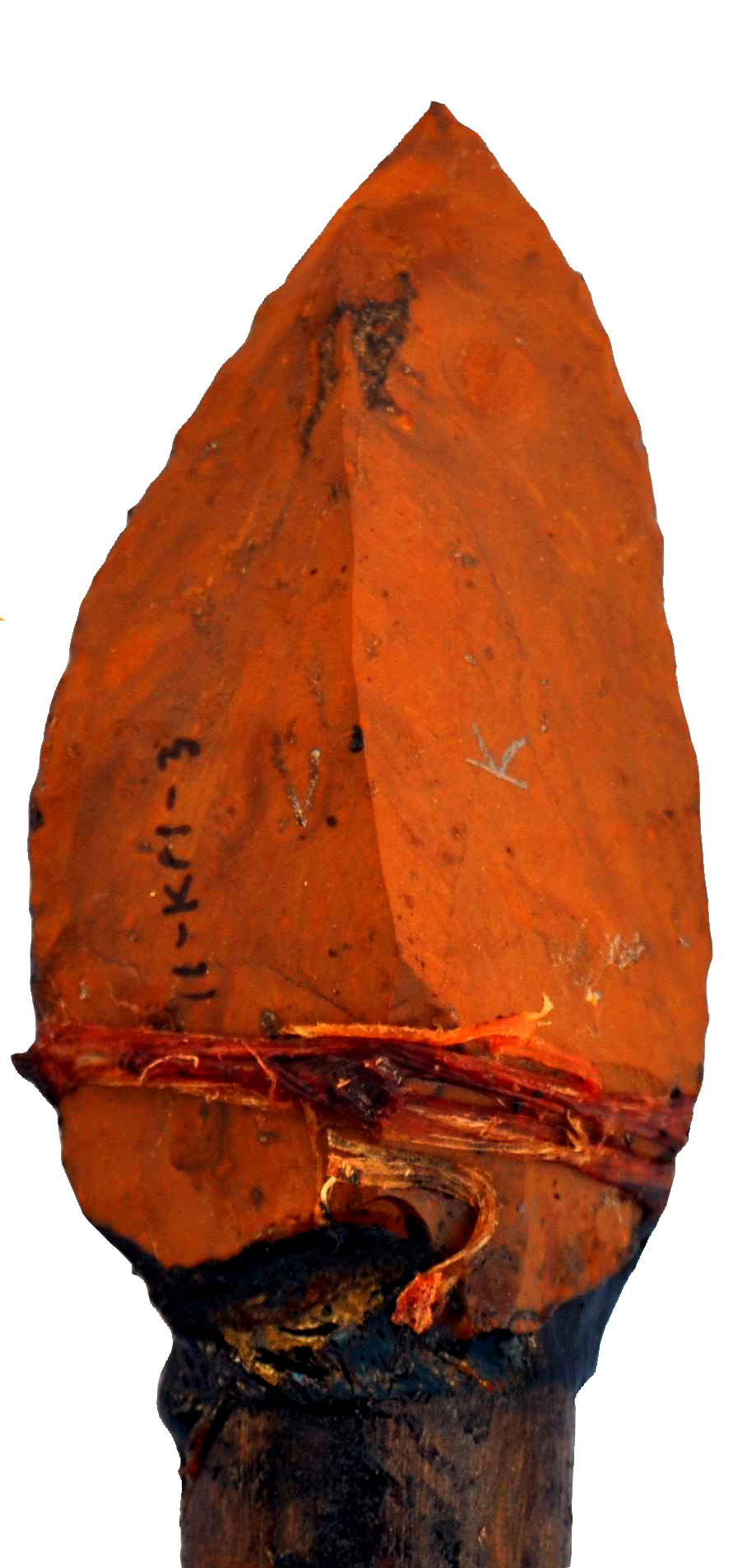 Analysis of 210 stone tools from the site of Kathu Pan in South Africa shows that people were probably hunting with stone-tipped spears by about 460,000 years ago, roughly 200,000 years earlier than previously believed. The study, led by University of Toronto doctoral candidate Jayne Wilkins, confirmed that the tools had broken in ways similar to other stone spear points that have been thrust or thrown into the bodies of animals. In addition, 23 of the tools appear to have been thinned at their bases to make them easier to attach to the shaft of a spear. To test their interpretation, the team made 32 replicas of the tools from Kathu Pan, hafted them to wooden dowels, and fired them into springbok carcasses using a crossbow that allowed for precise control of force. The replica spear points were damaged in ways similar to their ancient counterparts. The early date for the tools also suggests that the first stone-tipped spears were used by Homo heidelbergensis, the species of human that was the ancestor of both Neanderthals and modern humans.
Analysis of 210 stone tools from the site of Kathu Pan in South Africa shows that people were probably hunting with stone-tipped spears by about 460,000 years ago, roughly 200,000 years earlier than previously believed. The study, led by University of Toronto doctoral candidate Jayne Wilkins, confirmed that the tools had broken in ways similar to other stone spear points that have been thrust or thrown into the bodies of animals. In addition, 23 of the tools appear to have been thinned at their bases to make them easier to attach to the shaft of a spear. To test their interpretation, the team made 32 replicas of the tools from Kathu Pan, hafted them to wooden dowels, and fired them into springbok carcasses using a crossbow that allowed for precise control of force. The replica spear points were damaged in ways similar to their ancient counterparts. The early date for the tools also suggests that the first stone-tipped spears were used by Homo heidelbergensis, the species of human that was the ancestor of both Neanderthals and modern humans.
Messages from Quarantine
By SAMIR S. PATEL
Thursday, February 28, 2013
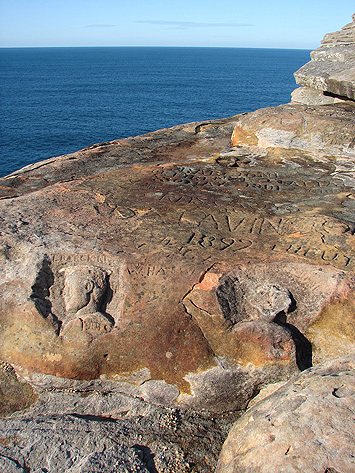 The North Head Quarantine Station near Sydney, Australia, was used to isolate people—usually newly arrived immigrants—suspected of carrying infectious disease. Between 1828 and 1984, 13,000 people passed through the station (more than 500 never left and were buried on site). Some of these people left records of their stays in the form of inscriptions on two sandstone outcrops at the site. The more than 1,000 inscriptions include everything from names and initials to medallion-like carvings to commemorative plaques. Many contain information about ships and their passengers. “They provide a material portal through which we can access something of the stories of the ordinary men, women, and children who migrated to Australia,” writes Annie Clarke of the University of Sydney. A more recent addition, likely from well after the site became a park, reads: “Rebecca will you marry me? Tim.” Good thing he signed it to avoid any confusion.
The North Head Quarantine Station near Sydney, Australia, was used to isolate people—usually newly arrived immigrants—suspected of carrying infectious disease. Between 1828 and 1984, 13,000 people passed through the station (more than 500 never left and were buried on site). Some of these people left records of their stays in the form of inscriptions on two sandstone outcrops at the site. The more than 1,000 inscriptions include everything from names and initials to medallion-like carvings to commemorative plaques. Many contain information about ships and their passengers. “They provide a material portal through which we can access something of the stories of the ordinary men, women, and children who migrated to Australia,” writes Annie Clarke of the University of Sydney. A more recent addition, likely from well after the site became a park, reads: “Rebecca will you marry me? Tim.” Good thing he signed it to avoid any confusion.
Let Slip the Pigeons of War
By ERIC A. POWELL
Thursday, February 28, 2013
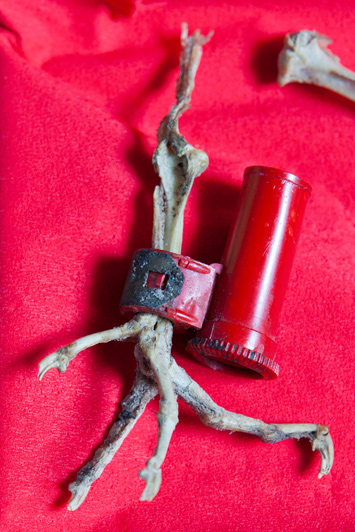 Colin Hill, a member of the Royal British Pigeon Racing Association, was astounded to learn last year that in the 1980s, the remains of a WWII courier pigeon were discovered in the unused chimney of a home near London. Among the doomed homing pigeon’s bones was a container holding a message consisting of 27 five-letter codes. Hill, also the curator of the pigeons exhibition at Bletchley Park, home of Britain’s wartime code-breaking effort, knew that the birds were often trusted with urgent military communications, so he couldn’t believe the discovery had gone unnoticed for three decades. Hill lobbied the GCHQ—the British equivalent of the National Security Agency—to decode the message, which may have been sent during the D-Day landings.
Colin Hill, a member of the Royal British Pigeon Racing Association, was astounded to learn last year that in the 1980s, the remains of a WWII courier pigeon were discovered in the unused chimney of a home near London. Among the doomed homing pigeon’s bones was a container holding a message consisting of 27 five-letter codes. Hill, also the curator of the pigeons exhibition at Bletchley Park, home of Britain’s wartime code-breaking effort, knew that the birds were often trusted with urgent military communications, so he couldn’t believe the discovery had gone unnoticed for three decades. Hill lobbied the GCHQ—the British equivalent of the National Security Agency—to decode the message, which may have been sent during the D-Day landings.
The government has declared the code unbreakable, but perhaps the heroic columbid didn’t die in vain. Its last mission has focused worldwide attention on the legacy of Allied homing pigeons. More than 250,000 saw active service in WWII, and 32 received the Dickin Medal, the highest British military award offered to animals. Among them was “G.I. Joe,” an American bird whose timely delivery of a message helped save 100 British lives in Italy. His stuffed remains are on display at Fort Monmouth, New Jersey.
Deconstructing a Zapotec Figurine
By ZACH ZORICH
Thursday, February 28, 2013
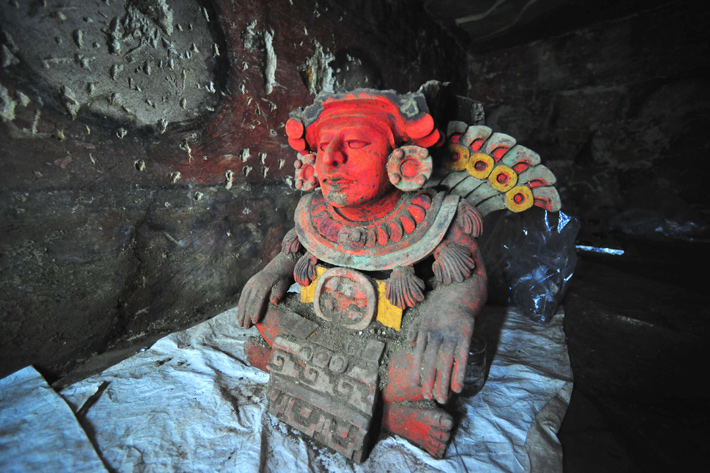
The site of Atzompa in southern Mexico was a suburb of the great Zapotec capital city of Monte Albán 1,200 years ago, when a man and a woman were laid to rest there in an elaborately painted tomb (“High Rise of the Dead,” November/December 2012). Recently, a team from Mexico’s National Institute of Anthropology and History finished excavating a colorful figurine from among the objects left with the deceased. Some researchers believe it may be an image of the man buried there, or of one of his ancestors. Interpretation of the figurine’s clothing, jewelry, and vivid coloration has much to say about Zapotec culture.
The seated statue is more than 30 inches tall and wears an elaborate headdress that would have been part of a costume symbolizing a person’s name and station within Zapotec society. According to Marc Zender, an expert in Mesoamerican iconography at Tulane University, painted figurines similar to this one were not rare among the Zapotec, but the variety of pigments used on this one seems to be something special.
A bar with three dots on the figurine’s apron is a glyph that represents the number eight. Above that is a circular glyph that means “earthquake” or “tremor.” Zender explains that the symbols spell out the day in the Zapotec ritual calendar when the person was born, and would also have been his name: Eight Tremor.
Advertisement
Advertisement
IN THIS ISSUE
Features
Pirates of the Original Panama Canal
Archaeology Island
A Soldier's Story
Letter from Cambodia
From the Trenches
Saving Northern Ireland's Noble Bog
Off the Grid
Mussel Mass in Lake Ontario
Europe's First Carpenters
Medici Mystery
Deconstructing a Zapotec Figurine
Messages from Quarantine
Let Slip the Pigeons of War
The First Spears
Burials and Reburials in Ancient Pakistan
Life (According to Gut Microbes)
Mapping Maya Cornfields
Inside a Painted Tomb
Minoan Mountaintop Manse
A Prehistoric Cocktail Party
Advertisement

Recent Issues
-
 May/June 2024
May/June 2024
-
 March/April 2024
March/April 2024
-
 January/February 2024
January/February 2024
-
 November/December 2023
November/December 2023
-
 September/October 2023
September/October 2023
-
 July/August 2023
July/August 2023
-
 May/June 2023
May/June 2023
-
 March/April 2023
March/April 2023
-
 January/February 2023
January/February 2023
-
 November/December 2022
November/December 2022
-
 September/October 2022
September/October 2022
-
 July/August 2022
July/August 2022
-
 May/June 2022
May/June 2022
-
 March/April 2022
March/April 2022
-
 January/February 2022
January/February 2022
-
 November/December 2021
November/December 2021
-
 September/October 2021
September/October 2021
-
 July/August 2021
July/August 2021
-
 May/June 2021
May/June 2021
-
 March/April 2021
March/April 2021
-
 January/February 2021
January/February 2021
-
 November/December 2020
November/December 2020
-
 September/October 2020
September/October 2020
-
 July/August 2020
July/August 2020
-
 May/June 2020
May/June 2020
-
 March/April 2020
March/April 2020
-
 January/February 2020
January/February 2020
-
 November/December 2019
November/December 2019
-
 September/October 2019
September/October 2019
-
 July/August 2019
July/August 2019
-
 May/June 2019
May/June 2019
-
 March/April 2019
March/April 2019
-
 January/February 2019
January/February 2019
-
 November/December 2018
November/December 2018
-
 September/October 2018
September/October 2018
-
 July/August 2018
July/August 2018
-
 May/June 2018
May/June 2018
-
 March/April 2018
March/April 2018
-
 January/February 2018
January/February 2018
-
 November/December 2017
November/December 2017
-
 September/October 2017
September/October 2017
-
 July/August 2017
July/August 2017
-
 May/June 2017
May/June 2017
-
 March/April 2017
March/April 2017
-
 January/February 2017
January/February 2017
-
 November/December 2016
November/December 2016
-
 September/October 2016
September/October 2016
-
 July/August 2016
July/August 2016
-
 May/June 2016
May/June 2016
-
 March/April 2016
March/April 2016
-
 January/February 2016
January/February 2016
-
 November/December 2015
November/December 2015
-
 September/October 2015
September/October 2015
-
 July/August 2015
July/August 2015
-
 May/June 2015
May/June 2015
-
 March/April 2015
March/April 2015
-
 January/February 2015
January/February 2015
-
 November/December 2014
November/December 2014
-
 September/October 2014
September/October 2014
-
 July/August 2014
July/August 2014
-
 May/June 2014
May/June 2014
-
 March/April 2014
March/April 2014
-
 January/February 2014
January/February 2014
-
 November/December 2013
November/December 2013
-
 September/October 2013
September/October 2013
-
 July/August 2013
July/August 2013
-
 May/June 2013
May/June 2013
-
 March/April 2013
March/April 2013
-
 January/February 2013
January/February 2013
-
 November/December 2012
November/December 2012
-
 September/October 2012
September/October 2012
-
 July/August 2012
July/August 2012
-
 May/June 2012
May/June 2012
-
 March/April 2012
March/April 2012
-
 January/February 2012
January/February 2012
-
 November/December 2011
November/December 2011
-
 September/October 2011
September/October 2011
-
 July/August 2011
July/August 2011
-
 May/June 2011
May/June 2011
-
 March/April 2011
March/April 2011
-
 January/February 2011
January/February 2011
Advertisement





